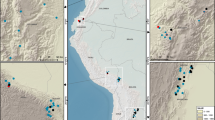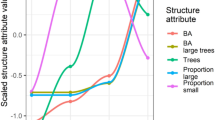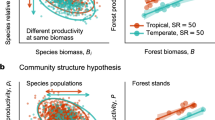Abstract
Ecological orthodoxy suggests that old-growth forests should be close to dynamic equilibrium, but this view has been challenged by recent findings that neotropical forests are accumulating carbon1,2 and biomass3,4, possibly in response to the increasing atmospheric concentrations of carbon dioxide5,6. However, it is unclear whether the recent increase in tree biomass has been accompanied by a shift in community composition. Such changes could reduce or enhance the carbon storage potential of old-growth forests in the long term. Here we show that non-fragmented Amazon forests are experiencing a concerted increase in the density, basal area and mean size of woody climbing plants (lianas). Over the last two decades of the twentieth century the dominance of large lianas relative to trees has increased by 1.7–4.6% a year. Lianas enhance tree mortality and suppress tree growth7, so their rapid increase implies that the tropical terrestrial carbon sink may shut down sooner than current models suggest8,9,10. Predictions of future tropical carbon fluxes will need to account for the changing composition and dynamics of supposedly undisturbed forests.
This is a preview of subscription content, access via your institution
Access options
Subscribe to this journal
Receive 51 print issues and online access
$199.00 per year
only $3.90 per issue
Buy this article
- Purchase on Springer Link
- Instant access to full article PDF
Prices may be subject to local taxes which are calculated during checkout



Similar content being viewed by others
References
Grace, J. et al. Carbon dioxide uptake by an undisturbed tropical rain-forest in Southwest Amazonia, 1992-1993. Science 270, 778–780 (1995)
Malhi, Y. et al. Carbon dioxide transfer over a Central Amazonian rain forest. J. Geophys. Res. Atmos. 103, 31593–31612 (1998)
Phillips, O. L. et al. Changes in the carbon balance of tropical forest: evidence from long-term plots. Science 282, 439–442 (1998)
Phillips, O. L. et al. Changes in the biomass of tropical forests: evaluating potential biases. Ecol. Appl. 12, 576–587 (2002)
Prentice, I. C. et al. in Intergovernmental Panel on Climate Change Third Assessment Report, Climate Change 2001: The Scientific Basis Ch. 3 (Cambridge Univ. Press, Cambridge, UK, 2001)
Malhi, Y. & Grace, J. Tropical forests and atmospheric carbon dioxide. Trends Ecol. Evol. 15, 332–337 (2000)
Schnitzer, S. A. & Bongers, F. The ecology of lianas and their role in forests. Trends Ecol. Evol. 17, 223–230 (2002)
Chambers, J. Q., Higuchi, N. & Tribuzy, E. S. Carbon sink for a century. Nature 410, 429–429 (2001)
Cox, P. M. et al. Acceleration of global warming due to carbon-cycle feedbacks in a coupled climate model. Nature 408, 184–187 (2000)
White, A., Cannell, M. G. R. & Friend, A. D. CO2 stabilisation, climate change and the terrestrial carbon sink. Glob. Change Biol. 6, 817–833 (2000)
Condit, R., Hubbell, S. P. & Foster, R. B. Assessing the response of plant functional types to climatic change in tropical forests. J. Vegn. Sci. 7, 405–416 (1996)
Körner, C. Biosphere responses to CO2 enrichment. Ecol. Appl. 10, 1590–1619 (2000)
Hegarty, E. E. & Caballé, G. in The Biology of Vines (eds Putz, F. E. & Mooney, H. A.) 313–336 (Cambridge Univ. Press, Cambridge, UK, 1991)
Condon, M. A., Sasek, T. W. & Strain, B. R. Allocation patterns in two tropical vines in response to increased atmospheric CO2 . Funct. Ecol. 6, 680–685 (1992)
Granados, J. & Korner, C. In deep shade, elevated CO2 increases the vigour of tropical climbing plants. Glob. Change Biol. (in the press)
Pérez-Salicrup, D. R., Sork, V. L. & Putz, F. E. Lianas and trees in Amazonian Bolivia. Biotropica 33, 34–37 (2001)
Laurance, W. F. et al. Rain forest fragmentation and the structure of Amazonian liana communities. Ecology 82, 105–116 (2001)
Phillips, O. L. & Gentry, A. H. Increasing turnover through time in tropical forests. Science 263, 954–958 (1994)
Phillips, O. L. The changing ecology of tropical forests. Biodivers. Cons. 6, 291–311 (1997)
Putz, F. E. Liana biomass and leaf-area of a tierra firme forest in the Rio Negro basin, Venezuela. Biotropica 15, 185–189 (1983)
Retallack, G. J. A 300 million year record of atmospheric carbon dioxide from fossil plant cuticles. Nature 411, 287–290 (2001)
Gentry, A. H. in The Biology of Vines (eds Putz, F. E. & Mooney, H. A.) 3–49 (Cambridge Univ. Press, Cambridge, UK, 1991)
Gentry, A. H. in The Biology of Vines (eds Putz, F. E. & Mooney, H. A.) 393–423 (Cambridge Univ. Press, Cambridge, UK, 1991)
Phillips, O. L. & Gentry, A. H. The useful plants of Tambopata, Peru. II: Additional hypothesis testing in quantitative ethnobotany. Econ. Bot. 47, 33–43 (1993)
Malhi, Y. et al. An international network to monitor the structure, composition and dynamics of Amazonian forests (RAINFOR). J. Vegn. Sci. (in the press)
Gerwing, J. J. & Lopes Farias, D. Integrating liana abundance and forest stature into an estimate of total aboveground biomass for an eastern Amazonian forest. J. Trop. Ecol. 16, 327–335 (2000)
Brown, S. Estimating Biomass and Biomass Change of Tropical Forests: a Primer (Food and Agriculture Organisation Forestry Paper 134, Rome, 1997)
Sombroek, W. G. Spatial and temporal patterns of Amazon rainfall: consequences for the planning of agricultural occupation and the protection of primary forests. Ambio 30, 388–396 (2001)
van Reeuwijk, L. P. (ed.) Procedures for Soil Analysis, Tech. Pap. 9, 5th edn (International Soil Reference and Information Centre, FAO, Rome, 1995)
Phillips, O. L. & Miller, J. Global Patterns of Plant Diversity: Alwyn H. Gentry's Forest Transect Data Set (Missouri Botanical Garden, St Louis, in the press)
Acknowledgements
We acknowledge the contributions of more than 50 field assistants in Peru, Ecuador and Bolivia, the residents of Constancia, Infierno, La Torre, Mishana and Florida, as well as logistical support from Instituto Nacional de Recursos Naturales (INRENA), Amazon Center for Environmental Education and Research (ACEER), Cuzco Amazónico Lodge, Explorama Tours SA, Instituto de Investigaciones de la Amazonía Peruana (IIAP), Parque Nacional Noel Kempff, Peruvian Safaris SA, Universidad Nacional de la Amazonía Peruana, and Universidad Nacional de San Antonio Abad del Cusco. Field research was supported by the EU Fifth Framework Programme (RAINFOR), the UK Natural Environment Research Council, the National Geographic Society, the American Philosophical Society, the National Science Foundation, the WWF-U.S./ Garden Club of America, Conservation International, the MacArthur and Mellon Foundations, US-AID, the Max-Planck Institute for Biogeochemistry and the Royal Society (Y.M.). The manuscript benefited from comments by C. Körner and N. Pitman. We are indebted to the late A.H. Gentry for helping to make this work possible.
Author information
Authors and Affiliations
Corresponding author
Ethics declarations
Competing interests
The authors declare that they have no competing financial interests.
Supplementary information
Rights and permissions
About this article
Cite this article
Phillips, O., Vásquez Martínez, R., Arroyo, L. et al. Increasing dominance of large lianas in Amazonian forests. Nature 418, 770–774 (2002). https://doi.org/10.1038/nature00926
Received:
Accepted:
Issue Date:
DOI: https://doi.org/10.1038/nature00926
This article is cited by
-
Climate and hydraulic traits interact to set thresholds for liana viability
Nature Communications (2022)
-
Contrasting responses of woody and grassland ecosystems to increased CO2 as water supply varies
Nature Ecology & Evolution (2022)
-
Are liana communities in linear canopy openings subject to edge effects?
Plant Ecology (2022)
-
Disturbance as a driver of trait assembly in liana communities in a semi-deciduous Atlantic Forest
Plant Ecology (2021)
-
Lianas research in the Neotropics: overview, interaction with trees, and future perspectives
Trees (2021)
Comments
By submitting a comment you agree to abide by our Terms and Community Guidelines. If you find something abusive or that does not comply with our terms or guidelines please flag it as inappropriate.



